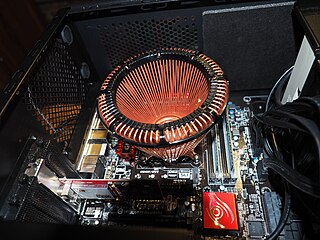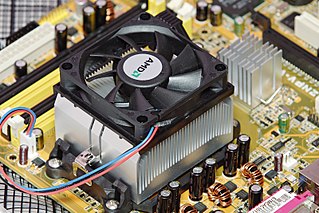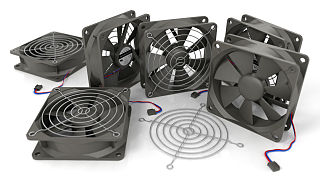
A graphics card is a computer expansion card that generates a feed of graphics output to a display device such as a monitor. Graphics cards are sometimes called discrete or dedicated graphics cards to emphasize their distinction to an integrated graphics processor on the motherboard or the central processing unit (CPU). A graphics processing unit (GPU) that performs the necessary computations is the main component in a graphics card, but the acronym "GPU" is sometimes also used to erroneously refer to the graphics card as a whole.

In computing, overclocking is the practice of increasing the clock rate of a computer to exceed that certified by the manufacturer. Commonly, operating voltage is also increased to maintain a component's operational stability at accelerated speeds. Semiconductor devices operated at higher frequencies and voltages increase power consumption and heat. An overclocked device may be unreliable or fail completely if the additional heat load is not removed or power delivery components cannot meet increased power demands. Many device warranties state that overclocking or over-specification voids any warranty, but some manufacturers allow overclocking as long as it is done (relatively) safely.

A quiet, silent or fanless PC is a personal computer that makes very little or no noise. Common uses for quiet PCs include video editing, sound mixing and home theater PCs, but noise reduction techniques can also be used to greatly reduce the noise from servers. There is currently no standard definition for a "quiet PC", and the term is generally not used in a business context, but by individuals and the businesses catering to them.

Case modification, commonly referred to as case modding, is the modification of a computer case or a video game console chassis. Modifying a computer case in any non-standard way is considered a case mod. Modding is done, particularly by hardware enthusiasts, to show off a computer's apparent power by showing off the internal hardware, and also to make it look aesthetically pleasing to the owner.

BTX is a form factor for motherboards, originally intended to be the replacement for the aging ATX motherboard form factor in late 2004 and early 2005.

Computer cooling is required to remove the waste heat produced by computer components, to keep components within permissible operating temperature limits. Components that are susceptible to temporary malfunction or permanent failure if overheated include integrated circuits such as central processing units (CPUs), chipsets, graphics cards, hard disk drives, and solid state drives.

A computer case, also known as a computer chassis, is the enclosure that contains most of the hardware of a personal computer. The components housed inside the case are referred as the internal hardware, while hardware outside the case are known as peripherals.

Lian Li Industrial Co., Ltd. is a Taiwanese computer case and accessories manufacturer. It is one of the largest manufacturers of aluminium computer cases in Taiwan and is also a major world competitor in the premium aftermarket computer case industry.

A computer fan is any fan inside, or attached to, a computer case used for active cooling. Fans are used to draw cooler air into the case from the outside, expel warm air from inside and move air across a heat sink to cool a particular component. Both axial and sometimes centrifugal (blower/squirrel-cage) fans are used in computers. Computer fans commonly come in standard sizes, such as 92 mm, 120 mm, 140 mm, and even 200–220 mm. Computer fans are powered and controlled using 3-pin or 4-pin fan connectors.

A CPU shim is a shim used between the CPU and the heat sink in a computer. Shims make it easier and less risky to mount a heatsink on the processor because it stabilizes the heatsink, preventing accidental damaging of the fragile CPU packaging. They help distribute weight evenly over the surface.
Antec, Inc. is a Taiwanese manufacturer of personal computer (PC) components and consumer tech products. Antec's principal products are computer cases and power supplies. Antec also offers PC cooling products, notebook accessories, and previously offered a line of Antec Mobile Products (A.M.P.) which included Bluetooth speakers, headphones, portable batteries, and charging hubs. Originally founded in 1986 in Fremont, California, the company is now headquartered in Taipei City, with additional offices in Rotterdam, Beijing, and Fremont, California. Antec pioneered a number of innovations in the PC case industry, including the switch from beige to black exterior color, and first cases specifically designed for noise reduction with the Sonata and P180. In 2011, Antec was purchased by Ming-Jong Technologies Ltd. of Taiwan, and the combined company adopted the Antec name. Antec products are sold in over 40 countries through its online retail platform, Amazon, and distribution partners. The company is publicly traded on the Taipei stock exchange under ticker 6276.

Cooler Master Technology Inc. is a computer hardware manufacturer based in Taipei,Taiwan. Founded in 1992, the company produces computer cases, power supplies, air and liquid CPU coolers, laptop cooling pads, and computer peripherals. Alongside its retail business, Cooler Master also is an original equipment manufacturer of cooling devices for other manufacturers, including NVIDIA, AMD, and EVGA. The company has sponsored major eSports events. Some of Cooler Master's products have won awards including the iF product design award.
Noctua is an Austrian computer hardware manufacturer of CPU coolers and computer fans with a primary focus on the enthusiast market. The company's inception occurred in 2005 through a joint venture partnership between the Austrian company Rascom Computer distribution Ges.m.b.H., established in August 2000, and the Taiwanese cooling specialist Kolink International Corporation.

Socket AM3+ is a modification of Socket AM3, which was released on February 9, 2009. AM3+ was released in mid-2011 designed for CPUs which use the AMD Bulldozer microarchitecture and retains compatibility with processors made for AM3. The Vishera line of AMD CPUs also all use Socket AM3+. It is the last AMD socket for which Windows XP support officially exists.

Arctic GmbH, formerly known as Arctic Cooling, is a German, Swiss-founded manufacturer of computer cooling components, mainly CPU and graphics card coolers, case fans and thermal compound. Since 2010, Arctic expanded its business by starting a range of products to cater other consumer demands beyond that of computer cooling hardware. Nowadays, Arctic also offers various consumer products—spanning audio, home entertainment and computer peripherals. In 2012, Arctic was nominated as one of the finalists in the annual PCR Awards.
The Freezer is the name of the CPU coolers from Arctic GmbH, which has been the company's staple product for many years. To most enthusiasts, Arctic is best known for their Freezer line of CPU coolers as well as their thermal compound called MX-2 and MX-4. The Freezer line of coolers is available in different fan speed, cooling capacity and motherboard compatibility to cater the needs of different type of users from HTPC users to enthusiasts and overclockers. The Freezer series CPU coolers are designed to lower the temperature inside your computer to enhance the stability and lifespan of the processor.
be quiet! is a German computer hardware brand owned by Listan GmbH, which manufactures power supply units, CPU coolers, computer cases and case fans. The main target groups for products in the be quiet! range are PC enthusiasts and computer game players as well as system integrators. The company's headquarters is in Glinde, close to Hamburg. At present, the firm also has branches in Poland and China and also Taiwan. The products of be quiet! are directly sold from Glinde to distributors and resellers worldwide. However, the major market of the be quiet! brand is Europe.

LGA 1700 is a zero insertion force flip-chip land grid array (LGA) socket, compatible with Intel desktop processors Alder Lake and Raptor Lake, which was first released in November 2021.

Socket AM5 is a zero insertion force flip-chip land grid array (LGA) CPU socket designed by AMD that is used for AMD Ryzen microprocessors starting with the Zen 4 microarchitecture. AM5 was launched in September 2022 and is the successor to AM4.


















